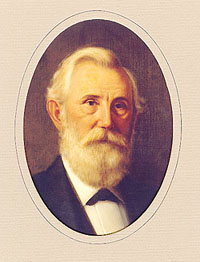Oran Milo Roberts facts for kids
Quick facts for kids
Oran Milo Roberts
|
|
|---|---|
 |
|
| 17th Governor of Texas | |
| In office January 21, 1879 – January 16, 1883 |
|
| Lieutenant | Joseph D. Sayers Leonidas J. Storey |
| Preceded by | Richard B. Hubbard |
| Succeeded by | John Ireland |
| Chief Justice Texas Supreme Court | |
| In office 1874–1879 |
|
| Delegate Texas Constitutional Convention 1866 | |
| Chief Justice Texas Supreme Court | |
| In office 1864–1865 |
|
| President of 1861 Secession Convention | |
| In office 1861–1861 |
|
| Texas Supreme Court | |
| In office 1856–1861 |
|
| District Judge (Texas) | |
| In office 1846–1855 |
|
| District Attorney (Texas) | |
| In office 1844–1845 |
|
| Alabama State Legislature | |
| Personal details | |
| Born | July 9, 1815 South Carolina |
| Died | May 19, 1898 (aged 82) Austin, Texas |
| Resting place | Oakwood Cemetery |
| Political party | Democratic |
| Spouses | Francis Wycliffe Edwards (1837–1883) Catherine E. Border (1887) |
| Alma mater | University of Alabama |
| Profession | Attorney |
| Military service | |
| Allegiance | |
| Branch/service | |
| Rank | |
| Commands | 11th Texas Infantry Regiment |
| Battles/wars | American Civil War |
Oran Milo Roberts (July 9, 1815 – May 19, 1898) was an important figure in Texas history. He served as the 17th Governor of Texas from 1879 to 1883. He was a member of the Democratic Party.
Roberts County, Texas, is named after him.
Contents
Early Life and Law Career
Oran Milo Roberts was born in South Carolina. He studied at the University of Alabama and became a lawyer in 1837. After serving in the Alabama legislature, he moved to Texas. There, he started a successful law business.
In 1844, the President of Texas, Sam Houston, chose Roberts to be a district attorney. This job meant he was the main lawyer for the government in a certain area. When Texas became a state in 1846, Governor James Pinckney Henderson appointed Roberts as a district judge. He also taught law at the University of San Augustine.
In 1856, Roberts was elected to the Texas Supreme Court. He became a strong supporter of "states' rights." This idea meant that states should have more power than the national government. As the country moved closer to the American Civil War, he supported the Southern states.
Role in the Civil War
In January 1861, Roberts was chosen to lead the Secession Convention in Austin. This was a big meeting where Texas leaders decided to leave the United States. Roberts helped pass the law that removed Texas from the Union.
In 1862, he left his judge job and joined the Confederate Army. He became a colonel in the Eleventh Texas Infantry. His unit was part of Walker's Texas Division. They fought in battles in Arkansas and Louisiana. Even while he was fighting, Roberts was elected Chief Justice of the Supreme Court in 1864. However, he lost this job in 1865 when the war ended.
After the War: Reconstruction and Governor
After the Civil War, during a time called Reconstruction, Roberts was part of a meeting to write a new Texas Constitution in 1866. He was also chosen to go to the U.S. Senate. But because of new laws, Southern states were under military rule. This meant their elected leaders were not allowed to join the U.S. Senate.
Roberts then went back to Gilmer, Texas, and started a law school in 1868. Many of his students became important judges and lawyers in Texas.
In 1874, Roberts was appointed Chief Justice of the Texas Supreme Court again. He helped rewrite many Texas laws. In 1878, he was nominated to run for governor. He won the election and served two terms.
As governor, Roberts focused on saving money for the state. His plan was called "pay as you go." This meant the state would not spend more money than it had. He sold public lands to pay off state debt and to help fund public schools. Even though this plan helped reduce debt, it slowed down the growth of public schools for a while.
During his time as governor, the current Capitol building in Austin was started. The first stone for the University of Texas was laid in 1882. More railroads were built across West Texas, which made the frontier safer.
Later Life and Legacy
In 1883, after his second term as governor, Roberts became a law professor at the University of Texas. He taught there for ten years. He greatly influenced many young lawyers in Texas. His students affectionately called him "Old Alcalde," which means "old mayor" or "old judge."
The University of Texas honored him by naming its alumni magazine "Alcalde." In 1963, a residence hall was also named after him. Roberts wrote several law books, including "The Elements of Texas Pleading" (1890). This book was used by law students for many years.
After leaving the university in 1893, he wrote about Texas history. He helped create the Texas State Historical Association and was its first president.
Family
Oran Milo Roberts was married to Frances W. Edwards from 1837 until her death in 1883. They had seven children. In 1887, he married Catherine E. Border. He is buried at the Oakwood Cemetery in Austin, Texas.

